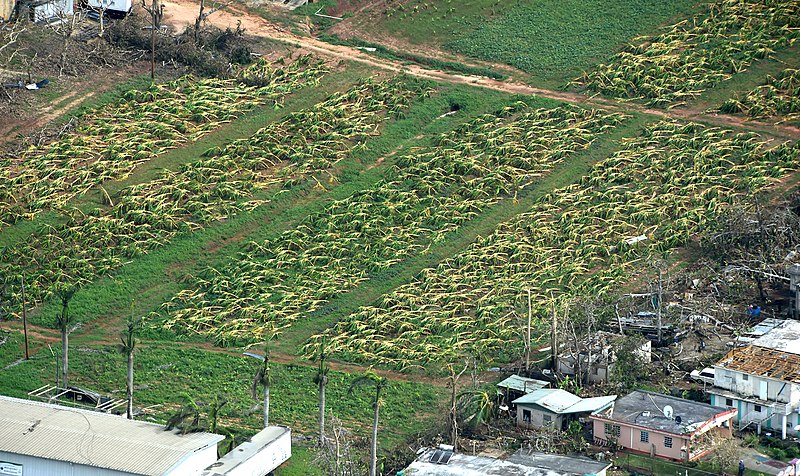 Crops destroyed by an extreme weather event. Photo credit: U.S. Air Force
Crops destroyed by an extreme weather event. Photo credit: U.S. Air Force
Food Insecurity: Why the U.S. Needs a Strategic Food Reserve
Russia’s recent invasion of Ukraine is exposing the fragility and volatility of international food security. The prospect of protracted war between them threatens to disrupt grain shipments from two of the world’s largest exporters of wheat (Russia is the single largest wheat exporter in the world, and Ukraine is the fifth) with profound spillover effects for stability in the global south – regions already ripe for conflict. Fourteen nations depend on Ukraine for at least 10% of their wheat supply, and certain states such as Lebanon (50%), Libya (43%), Malaysia (28%), Indonesia (28%), Yemen (22%), and Bangladesh (21%) are critically reliant on Ukraine for an even more substantial share of their wheat imports. Ukraine’s most fertile and arable land in the east is the most susceptible to Russia’s invasion, and sanctions could also hurt Russia’s ability to export foodstuffs. The crisis is already causing staple grain prices to rise, with wheat prices jumping to a 13-year high. Even American supermarkets will suffer from market shocks and higher prices – demonstrating the ripple effect of even minor and unmatured food insecurity challenges.
Food insecurity in the global south has the propensity to metastasize into even more dangerous instability. When people lack accessible and affordable food, their desperation for nutrition intensifies sociopolitical tensions, which leads to violence and popular unrest. When nations disintegrate under these forces, they leave power vacuums for malicious actors and terrorist elements to exploit, just as they did during the aftermath of Arab Spring. Drastically climbing bread prices first catalyzed popular uprisings against governments in Libya, Egypt, and Syria and led to partial or total state collapse. In Syria, ISIS then proliferated in the subsequent vacuum and the nation also became a door for Russian influence into the Middle East. The clear lesson here is the power food exerts over stability and therefore security.
Unfortunately, climate change is exacerbating the frequency and intensity of food challenges. Unseasonal temperature and precipitation fluctuations, rising sea levels, droughts, and extreme weather events can kill crops in a multiplicity of ways. This is already triggering food security issues. Up until the 1990s Syria was relatively fertile. However, a series of irregular multi-year droughts turned Syrian agricultural land to desert from 2006 to 2010. Crop yields plummeted and 85% of livestock died, forcing Syria to rely on imported grain. When another climate change induced drought hit Russia in 2010, its government halted all grain exports. International prices soared, triggering the bread riots that grew into the Arab Spring. As climate change continues the prevalence of food scarcity events will rise in conjunction.
So, what can be done to prevent states collapsing into anarchy as a result of food insecurity? One solution may be to recreate a food repository for both national and international food aid. The lack of a strategic food reserve leaves the U.S. exposed to domestic food insecurity and deprives policymakers of a potent and cost-effective means of preventing or mitigating the threat multiplying effects of food insecurity elsewhere. Historically, the U.S. Department of Agriculture administered a national grain repository for USAID, which it liquidated to stabilize global food prices during the 2008 global financial crisis. In a situation mirroring the inadequate stockpile of medical PPE before the Coronavirus Pandemic, the grain reserve became an all-cash trust for the purchase of food commodities instead of being replenished. USAID’s other two emergency programs, EFSP and Title II, similarly operate on cash transfers – a poor substitute for physical stock in a future scenario where crop output is affected by climate change. Title II also requires advanced delivery scheduling before USAID procures foodstuffs from the open market and arranges for shipment.
These programs are ill suited for crises because food often reaches its destination six months afterwards. This process effectively requires recipients to anticipate sometimes unpredictable food crises with fleeting intervention windows. As climate change increasingly and adversely affects U.S. crops, USAID’s ability to source food will similarly suffer in the absence of a stockpile. In Egypt, where combined Ukrainian-Russian exports account for 85% of grain consumption, no revolution has materialized due to a new national grain stock with 5.2 months of wheat provisions. China’s “strategic commodity reserves,” which includes 650 million tons of rice and wheat as well as corn and pork, also provides a useful model.
Ultimately, whether brought on by systemic forces of climate change or acute crises, food insecurity generates instability that spills over into other states. Preserving regional stability serves U.S. interests by reducing the appeal of extremist ideologies, hindering the efforts of malicious actors to transform states into proxies, and ultimately allowing the U.S. to focus its attention on long-term threats to the international order. Fortunately, food insecurity is also preventable, and a foodstuffs reserve would be a valuable grand strategic tool for promptly addressing food crises before they conflate into grander security threats.






